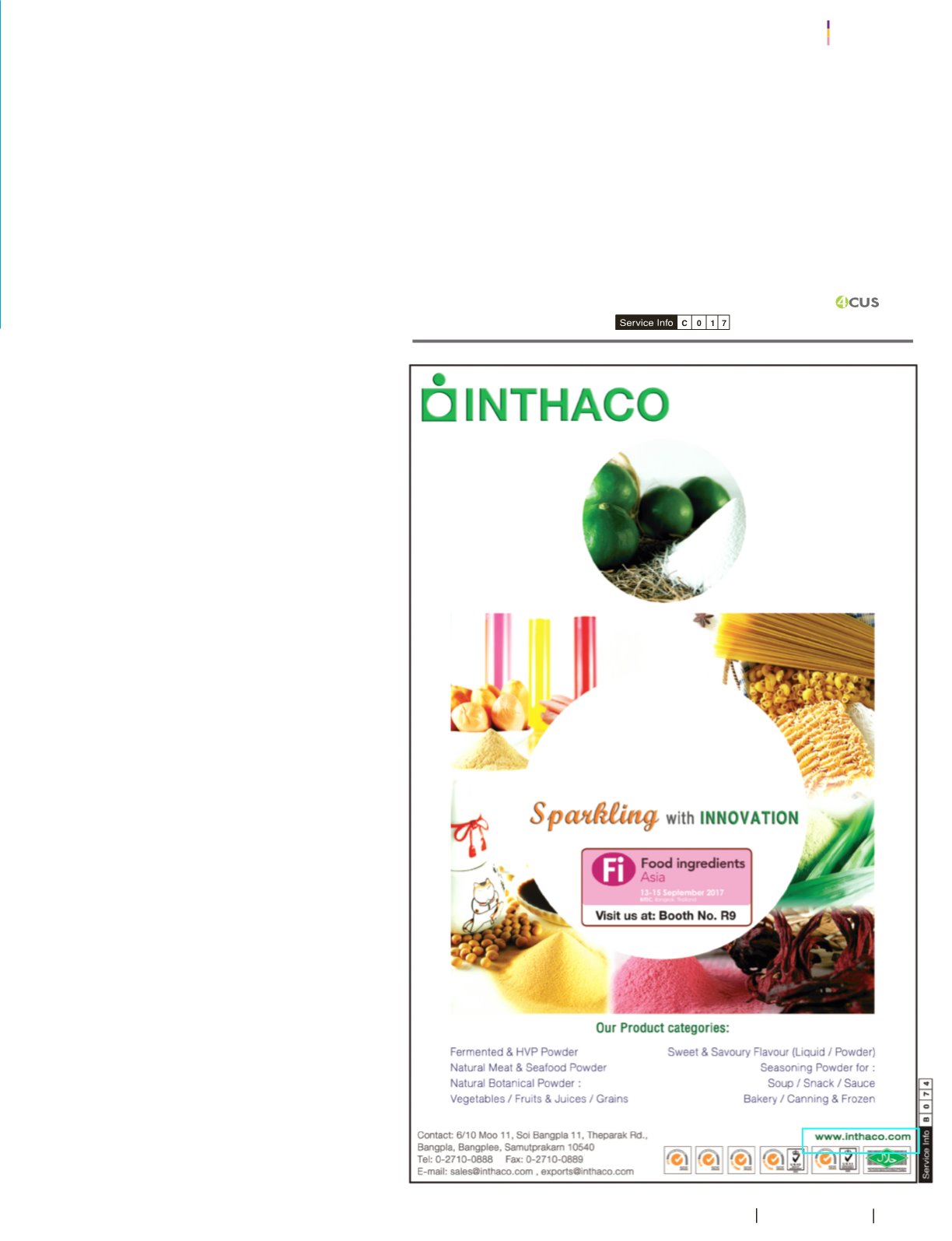
95
SEP2017 FOOD FOCUS THAILAND
SCOOP
Downstream-Upstream Coconut
Industry
Thailand is less competitive in exporting coconut
products than Indonesia, thePhilippinesand India– the
world’s leading coconut exporting nations – because
our coconut production is lower, whileour labor costs
are higher. However, Thai coconut products have
outstanding and unique features, which make them
more appealing to export markets. Aside from our
processed coconut products that are said to be of
superior quality than those of our rivals, Thai “Nam
Hom”coconutsaredistinct fromothercoconutvarieties
due to their unique fragranceandflavor, and theycan
begrownonly inThailand, largely in thecentral region.
Given this,KResearch isof theview thatThailandhas
thepotential toupgradeour coconut cultivation intoa
major agro-processing industry. The entire coconut
supply chain can bedeveloped, as follows:
Upstream: Coconut Growers
Due to a shortage of brown “mature” coconuts in
Thailand as a result of dwindling output even as
demandgrowsathomeandabroad,businesseshave
to import suchcoconuts fromneighboringcountries to
process intococonutmilk.Thiscoupledwith increased
demand for youngThai “NamHom” coconutsabroad,
particularly from China, leads us at KResearch to
project thatpricesofboth typesofcoconutwill increase
steadily,going forward.This, therefore,presentsgood
opportunities for farmersgrowingothercrops toswitch
to coconut cultivation, because it is in line with the
government’s action plans to promote integrated
coconut and soybean cultivation through various
measures that will assist farmers inmakinga smooth
transition.
However, farmersswitching fromother cropsmay
find it difficult to grow coconuts because it is time-
consuming; for instance, the dwarf variety takes 3-4
years tobear fruit,and the tallvariety takeseven longer
at 5-6 years. In addition, although coconuts can be
grownacross the country, they only thrive inareas of
loamysandandwithscattered rainfalls throughout the
year, while the “NamHom” variety growswell only in
areas having sufficient water, largely in the central
region. Moreover, the current coconut production in
Thailand remains low, while coconut cultivation is at
risk of infestations; therefore, farmers must improve
their know-how to copewith theseproblems.
Midstream: Traders andSMEs
Aspricesof commodities, including riceandcassava,
are projected to remain volatile in the near future,
related traders may consider switching to coconuts
because their prices are set to be more favorable.
Their coconuts can be supplied to SMEs and large
processing companies facing a shortage of this raw
material. Meanwhile, the popularity of “Nam Hom”
coconutshasattractedChinese traders to set up fruit
selection facilities inThailand topurchase thiscoconut
varietyat farms forexport toChina.This incidentcould
lead to a monopoly in trade, which could adversely
affect the Thai “Nam Hom” coconut price, going
forward.
SMEs processing primary coconut products,
including “NamHom” coconut juice, coconutmilkand
virgin cold-pressed coconut oil, will see bright export
prospects, especially in developed countries.
KResearchprojects thatdemand forcoconutproducts
abroad will continue to be strong, presenting
opportunities ahead for SMEs to expand related
production. In product R&D, SMEsmay start a small
project by themselves or in cooperation with their
businesspartners to introducenew coconut products
that will likely be successful, thanks to growing
popularity of suchproducts abroad.
Downstream: Coconut 4.0 Presents Product Development
Opportunities for LargeEnterprises
Using innovations inprocessingnewcoconutproductsmay requiresubstantial investment,
which is a restriction faced by SMEs. Therefore, large enterprisesmay capitalize on the
popularity of coconuts viaR&D todevelop value-addedproducts in linewith theThailand
4.0 policy, whichmay include coconut-based beverages in different flavors that are now
very popular abroad, plus foods and desserts, or hair & skin care products. They may
switch toorganicproducts that haveadded value, suchas coconutmilk. Brandingof their
organic coconut milkmay bemade viaThai restaurants abroad.
Due toThailand’s lowcoconutoutput relative toother leadingcoconutgrowingcountries,
Thai entrepreneursmayhave to focusonbrandinganduseR&D to improve theirproducts,
targeting nichemarkets. Such efforts are needed to differentiate themselves from rivals
andaddvalue to theircoconutproducts.Largeenterprisesmayconsider investing inmajor
coconutgrowingcountriesso that theycansecurestable rawmaterial supplies, thushelping
them reduceprocessing costs and avoid such shortages in the long term.


